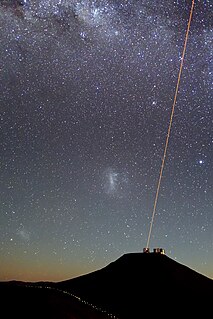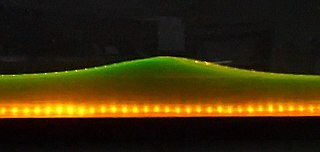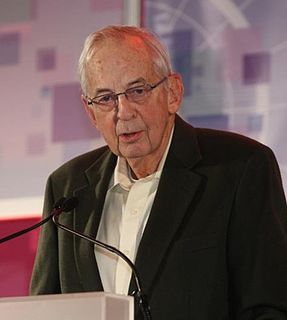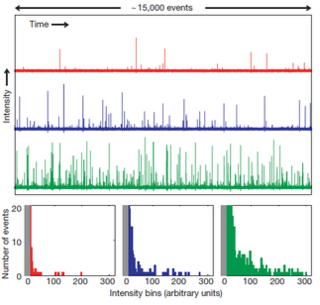Related Research Articles

Nonlinear optics (NLO) is the branch of optics that describes the behaviour of light in nonlinear media, that is, media in which the polarization density P responds non-linearly to the electric field E of the light. The non-linearity is typically observed only at very high light intensities (when the electric field of the light is >108 V/m and thus comparable to the atomic electric field of ~1011 V/m) such as those provided by lasers. Above the Schwinger limit, the vacuum itself is expected to become nonlinear. In nonlinear optics, the superposition principle no longer holds.

Optics is the branch of physics that studies the behaviour and properties of light, including its interactions with matter and the construction of instruments that use or detect it. Optics usually describes the behaviour of visible, ultraviolet, and infrared light. Because light is an electromagnetic wave, other forms of electromagnetic radiation such as X-rays, microwaves, and radio waves exhibit similar properties.

An optical amplifier is a device that amplifies an optical signal directly, without the need to first convert it to an electrical signal. An optical amplifier may be thought of as a laser without an optical cavity, or one in which feedback from the cavity is suppressed. Optical amplifiers are important in optical communication and laser physics. They are used as optical repeaters in the long distance fiberoptic cables which carry much of the world's telecommunication links.

In mathematics and physics, a soliton or solitary wave is a self-reinforcing wave packet that maintains its shape while it propagates at a constant velocity. Solitons are caused by a cancellation of nonlinear and dispersive effects in the medium. Solitons are the solutions of a widespread class of weakly nonlinear dispersive partial differential equations describing physical systems.

In optics, and by analogy other branches of physics dealing with wave propagation, dispersion is the phenomenon in which the phase velocity of a wave depends on its frequency; sometimes the term chromatic dispersion is used for specificity to optics in particular.
Mode locking is a technique in optics by which a laser can be made to produce pulses of light of extremely short duration, on the order of picoseconds (10−12 s) or femtoseconds (10−15 s). A laser operated in this way is sometimes referred to as a femtosecond laser, for example, in modern refractive surgery. The basis of the technique is to induce a fixed phase relationship between the longitudinal modes of the laser's resonant cavity. Constructive interference between these modes can cause the laser light to be produced as a train of pulses. The laser is then said to be "phase-locked" or "mode-locked".
In physics, two wave sources are coherent if their frequency and waveform are identical. Coherence is an ideal property of waves that enables stationary interference. It contains several distinct concepts, which are limiting cases that never quite occur in reality but allow an understanding of the physics of waves, and has become a very important concept in quantum physics. More generally, coherence describes all properties of the correlation between physical quantities of a single wave, or between several waves or wave packets.
A topological soliton or "toron" occurs when two adjoining structures or spaces are in some way "out of phase" with each other in ways that make a seamless transition between them impossible. One of the simplest and most commonplace examples of a topological soliton occurs in old-fashioned coiled telephone handset cords, which are usually coiled clockwise. Years of picking up the handset can end up coiling parts of the cord in the opposite counterclockwise direction, and when this happens there will be a distinctive larger loop that separates the two directions of coiling. This odd looking transition loop, which is neither clockwise nor counterclockwise, is an excellent example of a topological soliton. No matter how complex the context, anything that qualifies as a topological soliton must at some level exhibit this same simple issue of reconciliation seen in the twisted phone cord example.

An optical vortex is a zero of an optical field; a point of zero intensity. The term is also used to describe a beam of light that has such a zero in it. The study of these phenomena is known as singular optics.

A solid-state laser is a laser that uses a gain medium that is a solid, rather than a liquid as in dye lasers or a gas as in gas lasers. Semiconductor-based lasers are also in the solid state, but are generally considered as a separate class from solid-state lasers, called laser diodes.
A fiber laser is a laser in which the active gain medium is an optical fiber doped with rare-earth elements such as erbium, ytterbium, neodymium, dysprosium, praseodymium, thulium and holmium. They are related to doped fiber amplifiers, which provide light amplification without lasing. Fiber nonlinearities, such as stimulated Raman scattering or four-wave mixing can also provide gain and thus serve as gain media for a fiber laser.

In optics, a supercontinuum is formed when a collection of nonlinear processes act together upon a pump beam in order to cause severe spectral broadening of the original pump beam, for example using a microstructured optical fiber. The result is a smooth spectral continuum. There is no consensus on how much broadening constitutes a supercontinuum; however researchers have published work claiming as little as 60 nm of broadening as a supercontinuum. There is also no agreement on the spectral flatness required to define the bandwidth of the source, with authors using anything from 5 dB to 40 dB or more. In addition the term supercontinuum itself did not gain widespread acceptance until this century, with many authors using alternative phrases to describe their continua during the 1970s, 1980s and 1990s.
In optics, the term soliton is used to refer to any optical field that does not change during propagation because of a delicate balance between nonlinear and linear effects in the medium. There are two main kinds of solitons:
Dissipative solitons (DSs) are stable solitary localized structures that arise in nonlinear spatially extended dissipative systems due to mechanisms of self-organization. They can be considered as an extension of the classical soliton concept in conservative systems. An alternative terminology includes autosolitons, spots and pulses.
In physics, a pulse is a generic term describing a single disturbance that moves through a transmission medium. This medium may be vacuum or matter, and may be indefinitely large or finite.
In physical optics or wave optics, a vector soliton is a solitary wave with multiple components coupled together that maintains its shape during propagation. Ordinary solitons maintain their shape but have effectively only one (scalar) polarization component, while vector solitons have two distinct polarization components. Among all the types of solitons, optical vector solitons draw the most attention due to their wide range of applications, particularly in generating ultrafast pulses and light control technology. Optical vector solitons can be classified into temporal vector solitons and spatial vector solitons. During the propagation of both temporal solitons and spatial solitons, despite being in a medium with birefringence, the orthogonal polarizations can copropagate as one unit without splitting due to the strong cross-phase modulation and coherent energy exchange between the two polarizations of the vector soliton which may induce intensity differences between these two polarizations. Thus vector solitons are no longer linearly polarized but rather elliptically polarized.

James Power Gordon was an American physicist known for his work in the fields of optics and quantum electronics. His contributions include the design, analysis and construction of the first maser in 1954 as a doctoral student at Columbia University under the supervision of C. H. Townes, development of the quantal equivalent of Shannon's information capacity formula in 1962, development of the theory for the diffusion of atoms in an optical trap in 1980, and the discovery of what is now known as the Gordon-Haus effect in soliton transmission, together with H. A. Haus in 1986. Gordon was a member of the National Academy of Engineering and the National Academy of Sciences.

Optical rogue waves are rare pulses of light analogous to rogue or freak ocean waves. The term optical rogue waves was coined to describe rare pulses of broadband light arising during the process of supercontinuum generation—a noise-sensitive nonlinear process in which extremely broadband radiation is generated from a narrowband input waveform—in nonlinear optical fiber. In this context, optical rogue waves are characterized by an anomalous surplus in energy at particular wavelengths or an unexpected peak power. These anomalous events have been shown to follow heavy-tailed statistics, also known as L-shaped statistics, fat-tailed statistics, or extreme-value statistics. These probability distributions are characterized by long tails: large outliers occur rarely, yet much more frequently than expected from Gaussian statistics and intuition. Such distributions also describe the probabilities of freak ocean waves and various phenomena in both the man-made and natural worlds. Despite their infrequency, rare events wield significant influence in many systems. Aside from the statistical similarities, light waves traveling in optical fibers are known to obey the similar mathematics as water waves traveling in the open ocean, supporting the analogy between oceanic rogue waves and their optical counterparts. More generally, research has exposed a number of different analogies between extreme events in optics and hydrodynamic systems. A key practical difference is that most optical experiments can be done with a table-top apparatus, offer a high degree of experimental control, and allow data to be acquired extremely rapidly. Consequently, optical rogue waves are attractive for experimental and theoretical research and have become a highly studied phenomenon. The particulars of the analogy between extreme waves in optics and hydrodynamics may vary depending on the context, but the existence of rare events and extreme statistics in wave-related phenomena are common ground.
Kerr frequency combs are optical frequency combs which are generated from a continuous wave pump laser by the Kerr nonlinearity. This coherent conversion of the pump laser to a frequency comb takes place inside an optical resonator which is typically of micrometer to millimeter in size and is therefore termed a microresonator. The coherent generation of the frequency comb from a continuous wave laser with the optical nonlinearity as a gain sets Kerr frequency combs apart from today’s most common optical frequency combs. These frequency combs are generated by mode-locked lasers where the dominating gain stems from a conventional laser gain medium, which is pumped incoherently. Because Kerr frequency combs only rely on the nonlinear properties of the medium inside the microresonator and do not require a broadband laser gain medium, broad Kerr frequency combs can in principle be generated around any pump frequency.
Semiconductor saturable-absorber mirrors (SESAMs) are a type of saturable absorber used in mode locking lasers.
References
- ↑ S. Weinberg, The Quantum Theory of Fields, Vol. 2. Chap 23, Cambridge University Press (1995).
- ↑ Han Zhang, D. Y. Tang, L. M. Zhao, X. Wu "Observation of polarization domain wall solitons in weakly birefringent cavity fiber lasers" arXiv:0907.5496v1
- ↑ H. Zhang, D. Y. Tang, L. M. Zhao and R. J. Knize, “Vector dark domain wall solitons in a fiber ring laser’’ OPTICS EXPRESS 18, 4428 (2010). "Archived copy" (PDF). Archived from the original (PDF) on 2011-07-16. Retrieved 2012-11-13.
{{cite web}}: CS1 maint: archived copy as title (link)